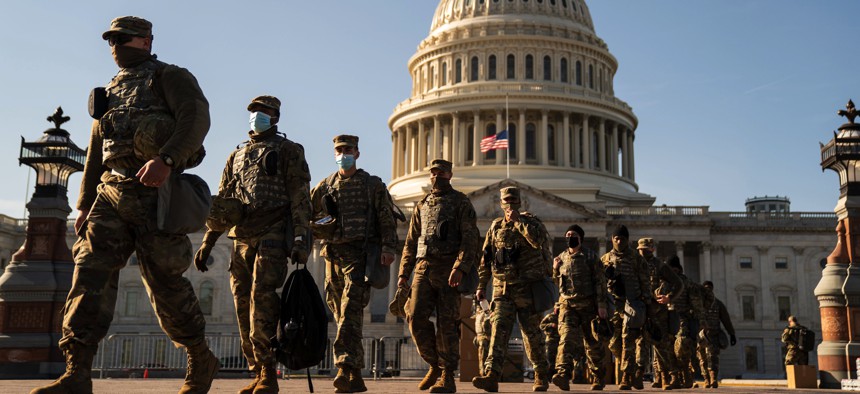
Members of the National Guard outside the U.S. Capitol on Jan. 14, 2021, a week after a pro-Trump insurrectionist mob breached its security. Kent Nishimura / Los Angeles Times via Getty Images
Army Leaders Have Agreed to Cap Troop Size, Top General Says
Gen. McConville and the acting secretary have agreed the force will not grow past 485,000 active-duty soldiers next year. But can they keep it from shrinking?
Army Chief of Staff Gen. James McConville has signaled for months that he would like to grow the force by as many as 70,000 additional soldiers, but that he expected he would have to make do with less. On Monday, the Army’s top general appeared to surrender, finally, to the idea that more limited defense spending levels are expected in President Joe Biden’s first Pentagon budget request.
“Right now what we’ve done—at least, the secretary and I have agreed to—is we’re not going to grow the Army above 485,000-ish with the resources that we’re anticipating now,” Army Chief of Staff Gen. James McConville said during a virtual discussion Monday with the Atlantic Council.
This appears to be the first time he and acting Army Secretary John Whitley have said they had reached an agreement on the total number of active-duty soldiers for the 2022 budget. The number marks no change from the Army's current active-duty end strength, and is the same number of soldiers the service had before the 9/11 terrorist attacks, McConville said.
Monday’s comments mark a turning point for McConville, who just last week told the House Appropriations subcommittee on defense that he’d like to grow the force up to between 540,000 to 550,000 soldiers. But he added that he understood the Army could not afford that in the 2022 budget.
“But what we must do is keep that force we have ready,” he said.
McConville also said in March that he would like to increase the force, but noted he also had to consider funding new and improved weapons programs.
“We really don't want to make it any smaller,” McConville said during a Association of the U.S. Army virtual event. “We'd like to make it bigger, but what we have to do is prioritize.”
With McConville’s hopes for a larger force apparently dashed, Whitley is now focused on relieving some of the burdens placed on the current force.
The Army is already “fully committed” with its operational requirements and does not have enough personnel to meet the country’s demands, Whitley said Monday during the Atlantic Council discussion.
“So it becomes a conversation of what requirements are going to be … lifted from us. And that’s not a conversation we can have in the Army unilaterally,” Whitley said. “We have to talk to our leadership in the Office of Secretary of Defense, and say, ‘Where is it that we are going to get relief from requirements?’” he said.
Christine Wormuth—Biden’s pick for Army secretary—is scheduled to appear before the Senate Armed Services Committee on Thursday morning for her nomination hearing. If confirmed, she would be the first woman to lead the Army.




